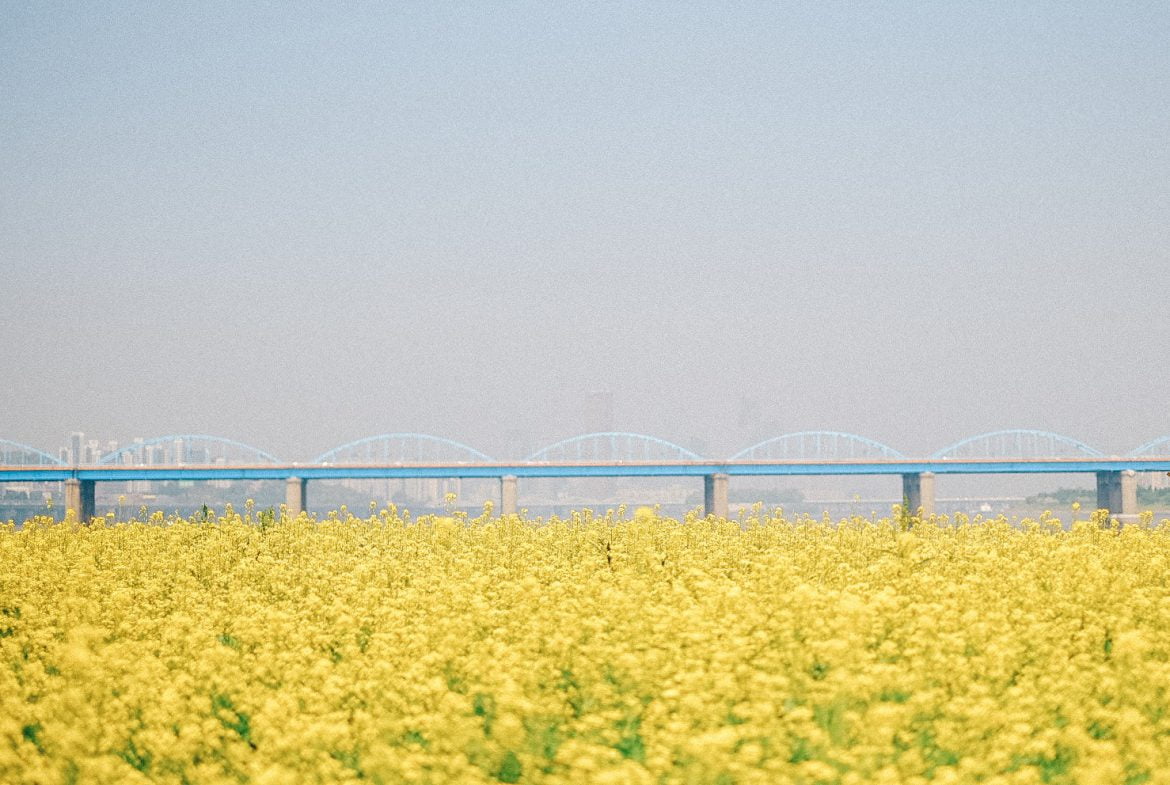One undeniable reason why spring is the best season (probably not to those who have pollen allergy) is dazzling flowers popping up everywhere. In early May, spring rewards us with bright yellow seas of canola flowers in bloom.
In Korea, people in Jeju Island and Busan are the very first to witness the blossoming of spring flowers including canolas. Luminous in their yellow glow, the canola fields situated in this southernmost region have drawn thousands of visitors to frolic each spring, making them the most famous venues for canola sightseeing in Korea.
Fortunately, you do not need to travel that far just to see those glowing canolas unless you’d like to explore Korea beaches and volcanic landscape too, which are certainly worth a visit. Here I have made a list of hidden spots in Seoul or in the neighboring city where you can admire the glorious canolas in their blooms.
1. Hangang Seoraeseom/Seorae Island (#서래섬유채꽃축제*)
It is an artificial island located by the Han riverbank. The island is also not far from the famous Banpo Bridge and Sevit floating islands. In the first or second week of May each year, Canola Festival is held at Seoraesom. This festival is one of the landmark spring celebrations in Seoul where a glorious view of canola flowers and Han river is boasted.


Access to Seoraeseom
Seoul Subway:
Sinbanpo station (신반포역) Line 9 --> Exit 1 --> 15 to 20 min walk
Gubanpo station (구반포역) Line 9 --> Exit 2 --> 15 to 20 min walk
Free shuttle bus to Sevitsom:
Bus stop at Express Bus Terminal Station (고속터미널역) Exit 6 (more shuttle bus info here)
2. Guri Hangang Park (#구리한강유채꽃축제*)
Guri Hangang Park is one of the top Han river citizen’s parks that is known for its ample field of picturesque spring and autumn flower blooms. It is actually famous for cosmos blossoms viewing annually in September. Nonetheless, in May, the park turns yellow with canola flowers.
Access to Guri Hangang Park
Seoul Subway + Bus:
Jamsil station (잠실역) Line 2 or 8 --> Exit 7 --> G bus stop --> take bus number 1670, 2000, 1100, 1700, 7007, 1200-1, or 2000-1 --> get off at Topyeong IC (토평IC only one stop away) --> 15 to 20 min walk
3. Anyang Stream/Gwangmyeong Bridge (#안양천유채꽃* / #광명대교*)
Anyangcheon or Anyang stream flows through Anyang City. One of its major tributaries run to the border with Gwangmyeong City. Here, at a very specific location near Guil Station, a tranquil rest spot has been discovered by the Gwangmyeong Bridge. In May, this particular area glows with canola blooms in the field by the riverbank.
Access to Anyang Stream
Seoul Subway
Guil station (구일역) Line 1 --> Exit 1 --> 20 min walk
4. Yanghwa Hangang Park (#양화한강공원*)
Yanghwa Hangang Park is located downstream from the popular Yeouido Hangang Park. Cycling along the river is the most preferable activity people would do when visiting the park. There, not as large as the fields from the three aforementioned venues but still gorgeous to look at, a sideway is occupied with pretty canola blooms in the early of May.
Access to Yanghwa Hangang Park
Seoul Subway:
Dangsan station (당산역) Line 2 or 9 --> Exit 4 --> 7 min walk (towards the Han River)
*A little tip: follow the hashtag on Instagram to discover more recent feed of the venue
Places Mentioned in This Post
Interested in a related tour package?
Did this entry help you? Or Did you enjoy my photos? Help support my small blog by giving a little cup of joe. I am always grateful when readers reach out wanting to support 🙂
p.s. This post is independently created. However, when you book or purchase something through the retail links, I may earn an affiliate commission to help keep Ploy’s Little Atlas running. Thank you very much for your support!
p.p.s All images used (unless specified) are owned by the author of the blog and permission is required for a repost. Please, reach out via social media channels to ask beforehand if you’d like to use them.






